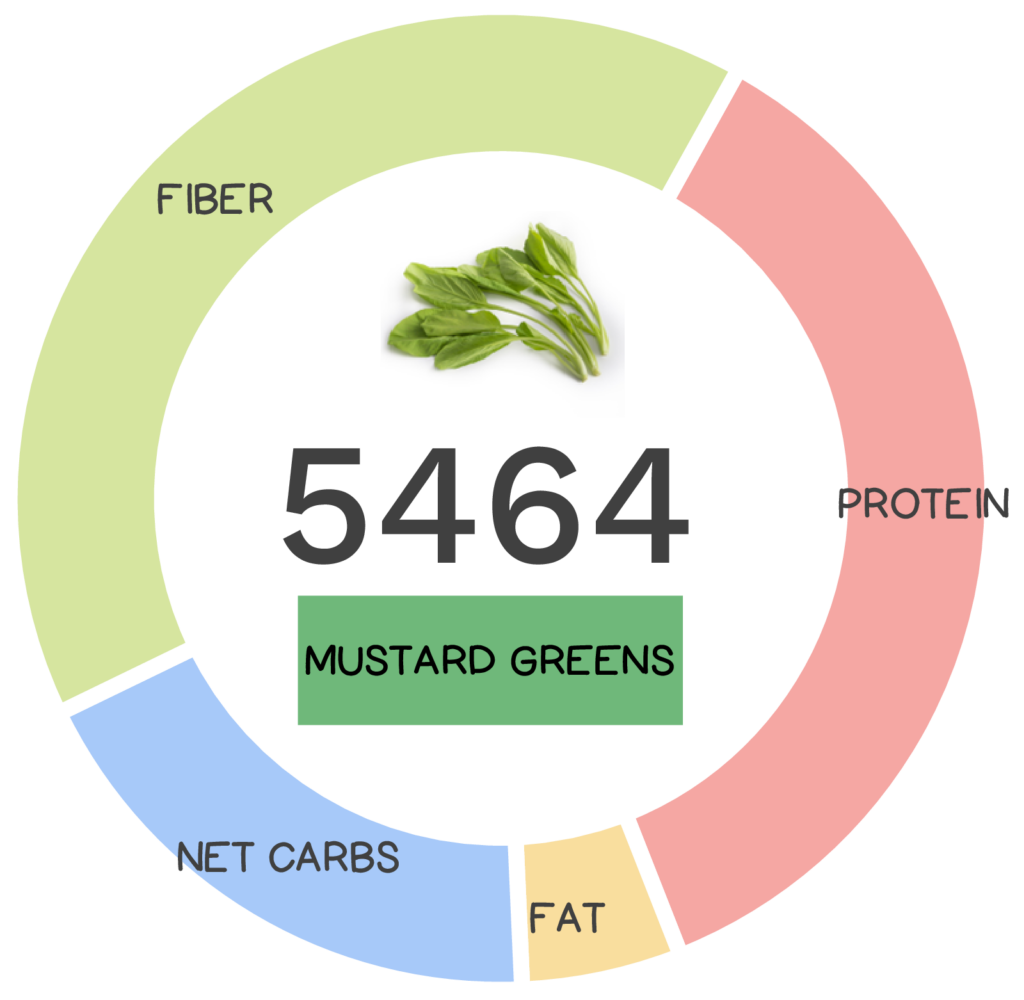
If you’re looking to add some “bite” to your meals, look no further than mustard greens (aka leaf mustard). This leafy green crucifer has a pungent, bitter, taste reminiscent of pepper, horseradish and you guessed it – mustard, that will add bold flavor to any meal. Popular in Asian and Southern-American cuisine, mustard greens are the strongest tasting vegetables referred to as bitter greens. Their “sting” can be a bit of an acquired taste, but they can be mixed with milder greens or cooked or pickled to tone down their flavor, in order to please even the pickiest of eaters. If you haven’t tried these nutrient powerhouses, you’re missing out – it’s definitely worth “mustering” up the courage to give them a chance!
Mustard greens are members of the cruciferous vegetable family, which includes other members such as broccoli, Brussels sprouts, cabbage, cauliflower, collard greens, kale, and rutabaga.
Mustard greens are members of the Brassicaceae (aka cruciferous) vegetable family, which includes other members such as broccoli, Brussels sprouts, cabbage, cauliflower, collard greens, kale, and rutabaga to name a few. Specifically, mustard greens is a generic name given to the leaves of cultivars of the brown mustard plant, Brassica juncea, which is the same plant whose seeds are used to make spicier French-style brown mustards, as well as being one source for canola oil (the other being rapeseed). Different cultivars exist and are grown for desirable characteristics with some being cultivated specifically for their oilseed (ground to prepare the famous condiment or pressed for their oil), while others are prized for their edible leaves, flowering heads (inflorescence), stems and roots. Brassica juncea is also commonly known as brown mustard, Chinese mustard, Indian mustard, leaf mustard, Oriental mustard, mustard spinach, and vegetable mustard. There are several varieties of mustard plants with edible leaves, but the most familiar one in the United States is curled-leaf mustard, also known as ‘American mustard’, ‘Southern mustard’ ‘Texas mustard’ or simply curly or curled mustard, which has very frilly leaves (similar to curly kale) and a peppery, spicy taste. In general, mustard greens can be broadly grouped into two categories – western and oriental (or Asian) mustard greens. Western greens include the curly-leaf variety in addition to mustard spinach, which has large, smooth, dark-green leaves that look like (you guessed it) spinach (surprised?). Asian mustards include mizuna, (also known as Japanese mustard) which is a Japanese green with bright green fern-like leaves, mibuna with narrow, strap-like leaves, and komatsuna with spinach-shaped leaves. There is also gai choy, (also known as Chinese mustard, Indian mustard, or head mustard), which has a large bulb like bok choy, and red mustard, which has rounded leaves with a purple tinge. Depending on what type you pick, the intensity of the flavor will vary, but all have that familiar ‘bite’ in common. Today, these plants are grown worldwide but they are believed to be native to Asia and Europe, where mustard seeds have been found in ancient Greek archaeological sites. Since mustard is one of the few spices that can grow in Europe, this plant was extremely important, so much so that Medieval European courts employed an official, known as the ‘mustardarius’, whose sole job was to oversee local mustard production!
Mustard greens can be broadly grouped into two categories – western and oriental (or Asian) mustard greens. Western greens include curled-leaf mustard and mustard spinach, while Asian greens include mizuna, mibuna, and komatsuna.
Interestingly, apart from their culinary value, mustard plants can be used in phytoremediation to remove heavy metals from contaminated soil and are sometimes grown as green manure (aka cover crops), acting like mulch, to suppress weeds between crops. The volatile oils contained within the plants have strong antimicrobial properties, such that they act as an organic pesticide for weeds and soil borne pathogens. Nature is so cool!
Learn What Foods to *ADD* to Your Diet
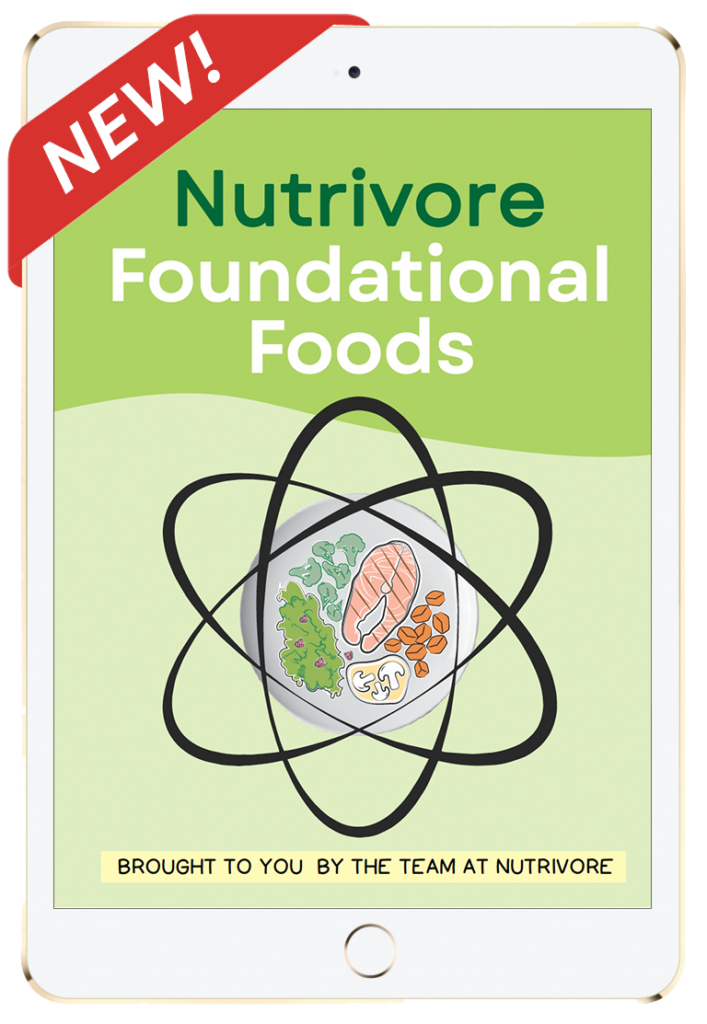
Nutrivore Foundational Foods
Learn what makes the 12 Nutrivore foundational food families nutritionally unique, their health benefits, which options are the most nutrient dense, how much of them to eat, plus various fun facts, practical pointers, and busting of common myths.
This very helpful resource will introduce you to new foods and expand your nutrition knowledge, making food choices easier!
Buy now for instant digital access.
Nutrivore Score for Mustard Greens – 5464
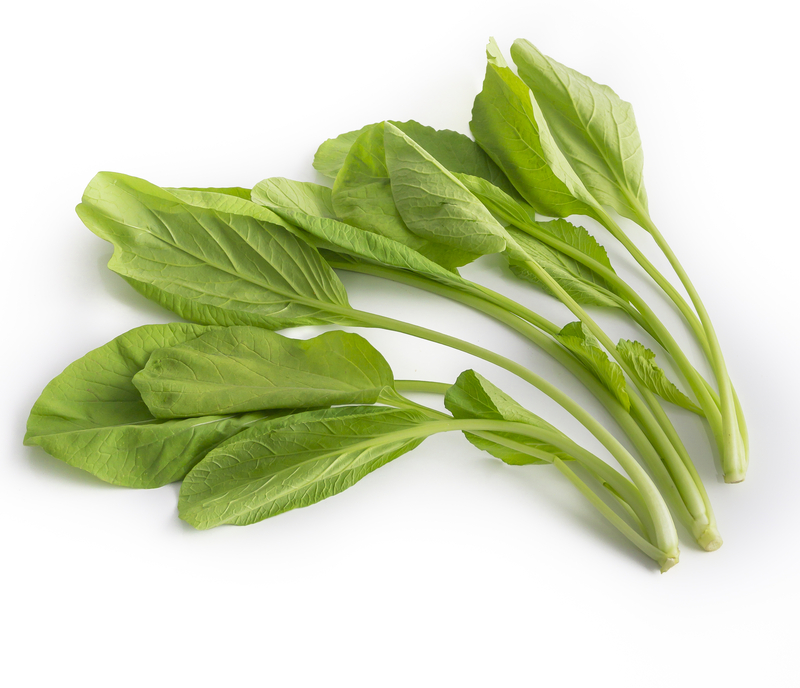
Mustard greens have a Nutrivore Score of 5464, making them a super nutrient-dense food! Plus, they are a low-carb and low-calorie-density food; the calorie count of mustard greens is only 15 calories per cup!
Per serving, mustard greens are a best source (>50% daily value) of carotenoids, glucosinolates, polyphenols, vitamin C, and vitamin K; an excellent source (20-50% daily value) of copper and manganese; and a good source (10-20% daily value) of calcium, dietary fiber, iron, vitamin A, vitamin B6 (pyridoxine), and vitamin E.
Ditch Diets. Embrace Nutrients. Start with this FREE Guide.
Sign up for the free Nutrivore Newsletter, your weekly, science-backed guide to improving health through nutrient-rich foods — without dieting harder —and get the Beginner’s Guide to Nutrivore delivered straight to your inbox!

Mustard Green Nutrition Facts
One serving of mustard greens is standardized to 2 cups, chopped or about 112 grams (4 ounces). When you cook mustard greens, they reduce in volume by approximately 60% which means: 2 1/2 cups raw mustard greens is roughly equivalent to 1 cup boiled mustard greens.
Mustard Green Nutrition Facts Per Serving
| Mustard greens, raw | Nutrivore Score: 5464 | Nutrient Density: Super! |
|---|---|---|
| Serving Size: 2 cups, chopped (112 grams) | Protein: 3.2 grams | Net Carbohydrates: 1.6 grams |
| Calories: 30 | Total Fat: 0.5 grams | Dietary Fiber: 3.6 grams |
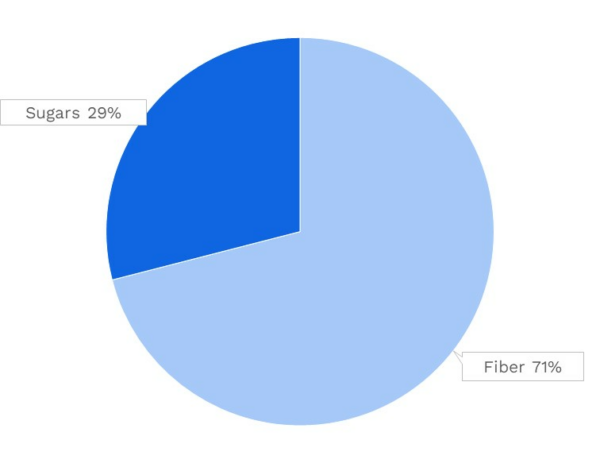
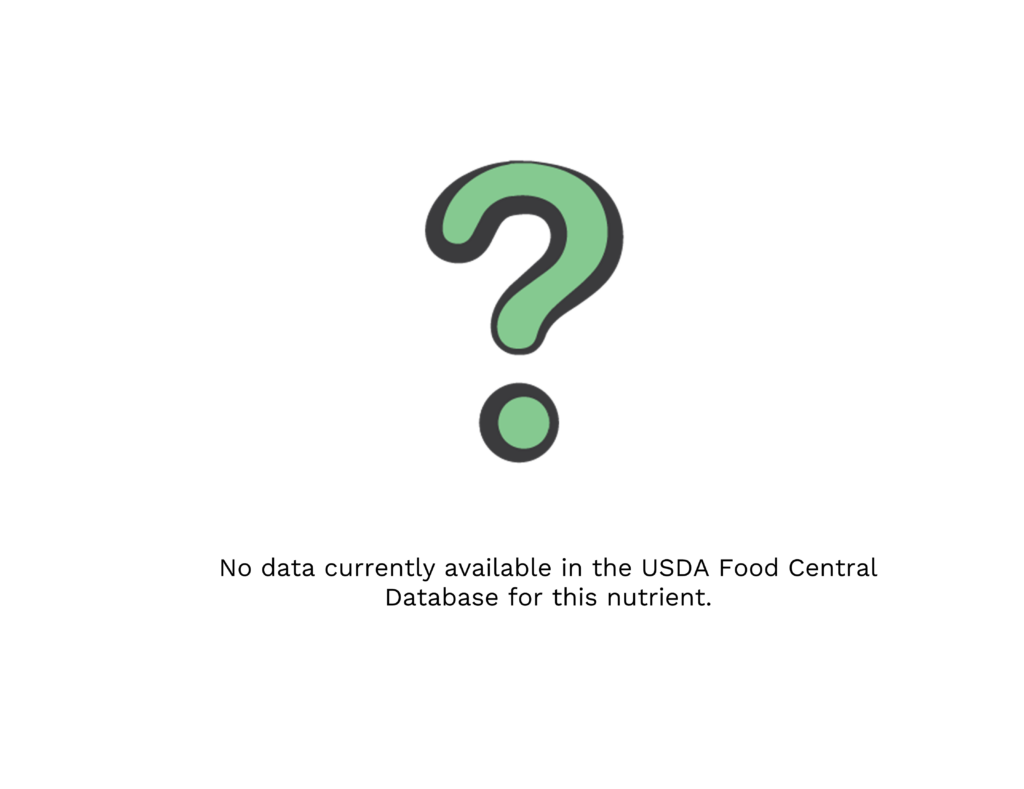
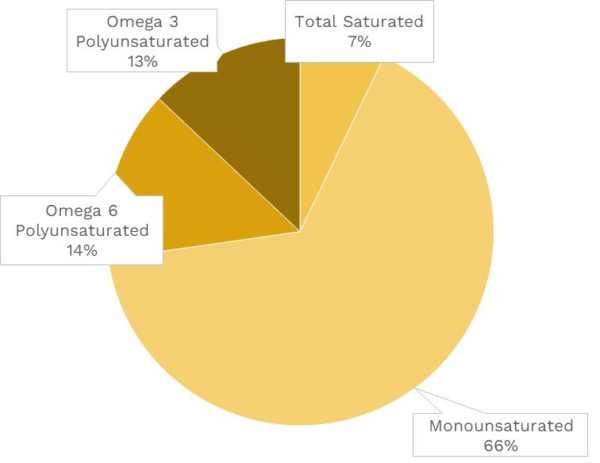
| VITAMINS | ||
|---|---|---|
| Vitamin A | 169.1 μg RAE | 19% DV |
| Vitamin B1 (Thiamin) | 89.6 μg | 7% DV |
| Vitamin B2 (Riboflavin) | 123.2 μg | 9% DV |
| Vitamin B3 (Niacin) | 0.9 mg | 6% DV |
| Vitamin B5 (Pantothenic Acid) | 0.2 mg | 5% DV |
| Vitamin B6 (Pyridoxine) | 201.6 μg | 12% DV |
| Vitamin B7 (Biotin) | ~ | ~ |
| Vitamin B9 (Folate) | 13.4 μg | 3% DV |
| Vitamin B12 (Cobalamin) | 0.0 μg | 0% DV |
| Vitamin C | 78.4 mg | 87% DV |
| Vitamin D (D2 + D3) | 0.0 μg | 0% DV |
| Vitamin E | 2.3 mg | 15% DV |
| Vitamin K | 288.4 μg | 240% DV |
| Choline | 0.6 mg | 0% DV |
| Myo-Inositol | 25.8 mg | ~ |
| CoQ10 | ~ | ~ |
| FUNCTIONAL FATS | ||
|---|---|---|
| MUFA | 0.1 g | 1% DV |
| ALA | 20.2 mg | 1% DV |
| EPA + DHA | 0.0 mg | 0% DV |
| CLA | ~ | ~ |
| Linoleic Acid | 0.0 g | 0% DV |
| MCT’s | 0.0 g | ~ |
| MINERALS | ||
|---|---|---|
| Calcium | 128.8 mg | 10% DV |
| Copper | 184.8 μg | 21% DV |
| Iodine | ~ | ~ |
| Iron | 1.8 mg | 10% DV |
| Magnesium | 35.8 mg | 9% DV |
| Manganese | 512.6 μg | 22% DV |
| Phosphorus | 65.0 mg | 5% DV |
| Potassium | 430.1 mg | 9% DV |
| Selenium | 1.0 μg | 2% DV |
| Sodium | 22.4 mg | 1% DV |
| Zinc | 0.3 mg | 3% DV |
| PHYTONUTRIENTS | ||
|---|---|---|
| Carotenoids | 6238.4 μg | ~ |
| Polyphenols | 412.9 mg | ~ |
| Phytosterols | ~ | ~ |
| Glucosinolates | 609.8 mg | ~ |
| Thiosulfinates | ~ | ~ |
| Betalains | ~ | ~ |
| AMINO ACIDS & PEPTIDES | ||
|---|---|---|
| Taurine | ~ | ~ |
| Ergothioneine | ~ | ~ |
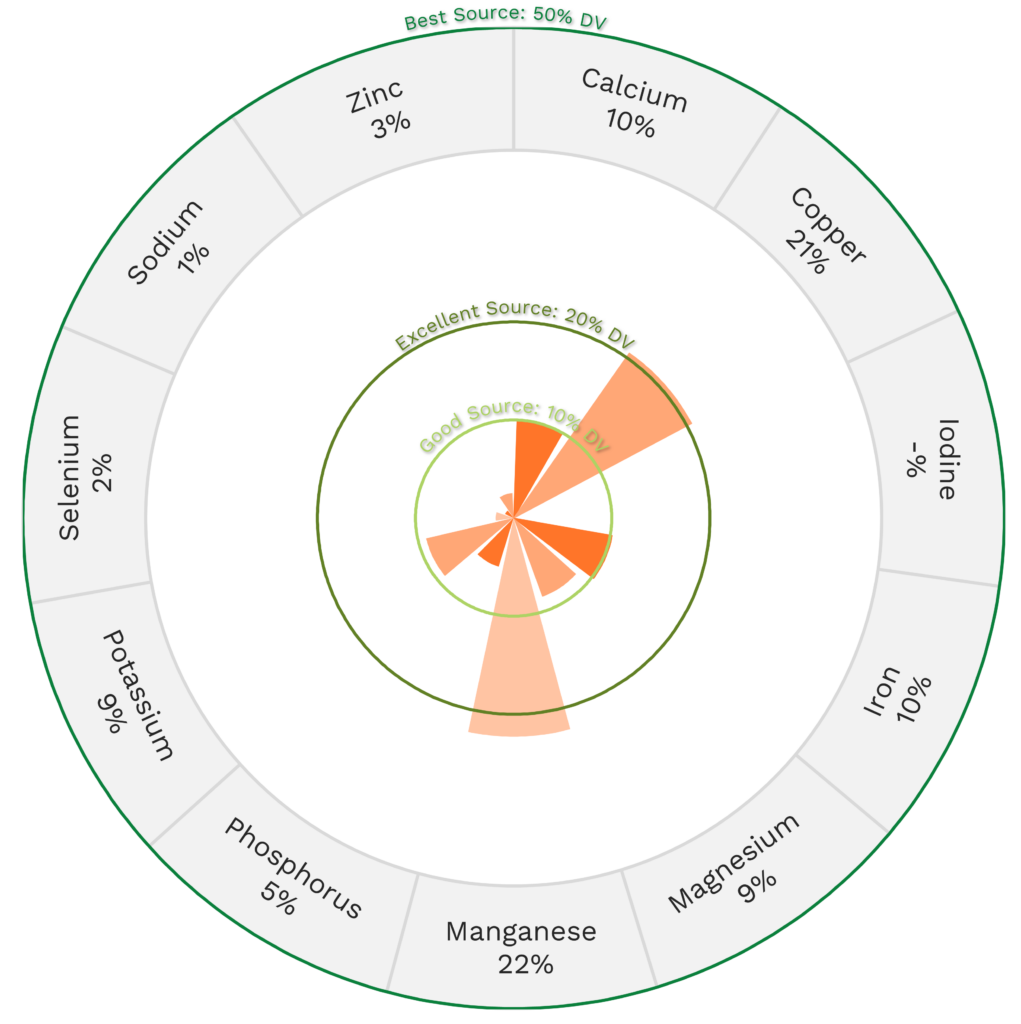
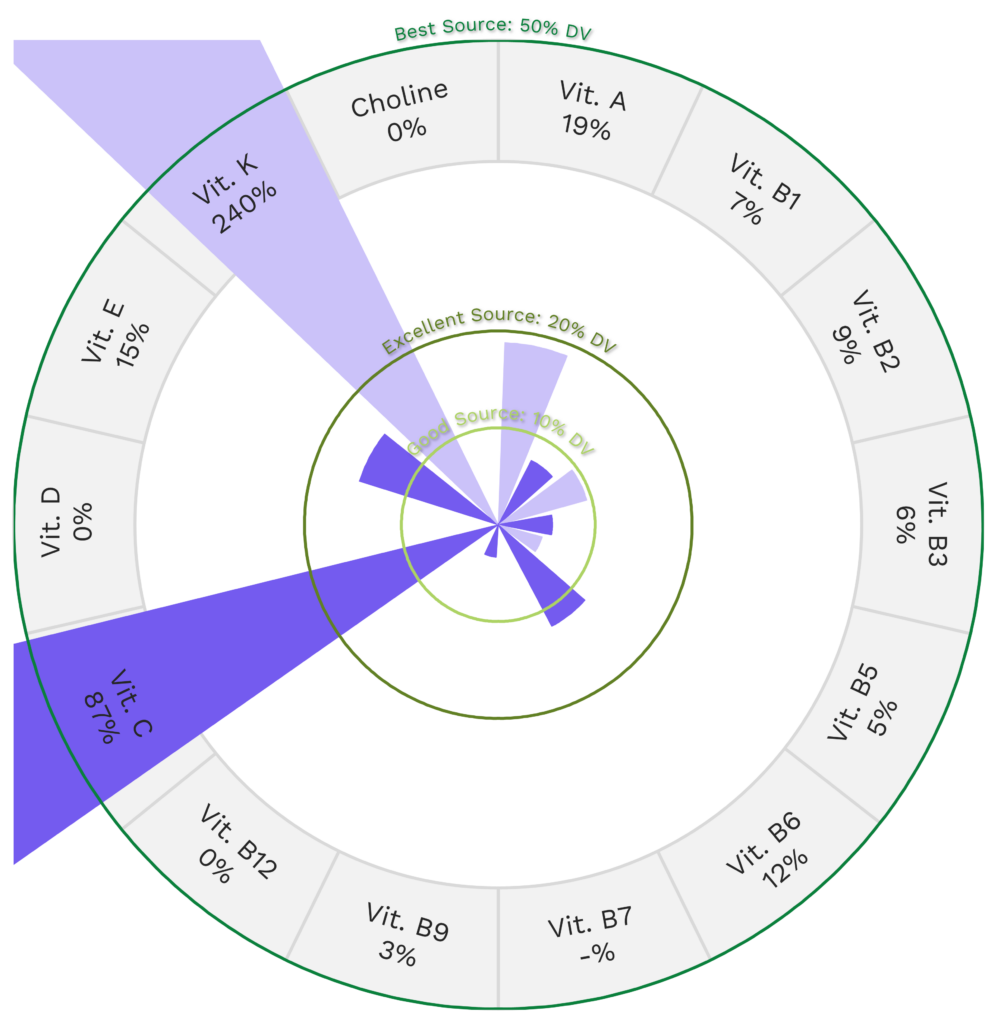
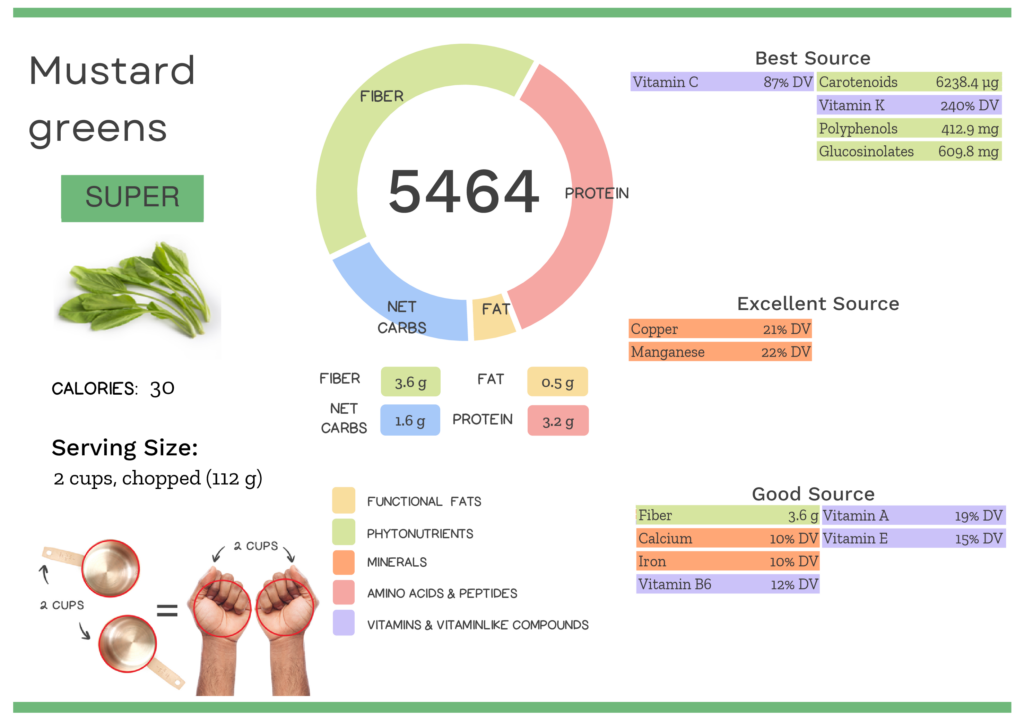
The Best Support to Build This Important Daily Habit!

Nutrivore Salad-a-Day Challenge
The Nutrivore Salad-a-Day Challenge e-book explains all the ways a daily salad can improve your health, plus includes a collection of 10 handy visual guides and food lists, like the Nutrivore Salad Matrix.
Plus, you’ll find 50+ recipes, including over 30 of our favorite salad recipes plus recipes for delicious dressings and tasty toppers.
Buy now for instant digital access.
Mustard Green Nutrition Varies With Cooking and Processing
The Nutrivore Score of mustard greens varies based on processing and method of preparation. For instance, frozen mustard greens are conveniently available year-round at the grocery store.
| NUTRIVORE SCORE | |
|---|---|
| Mustard greens, cooked, boiled, drained, with salt | 6859 |
| Mustard greens, cooked, boiled, drained, without salt | 6989 |
| Mustard greens, frozen, cooked, boiled, drained, with salt | 6469 |
| Mustard greens, frozen, cooked, boiled, drained, without salt | 6469 |
| Mustard greens, frozen, unprepared | 5507 |
| Mustard greens, raw | 5464 |
Mustard Green Nutrition Varies With Variety
Mustard greens is a generic name given to the leaves of cultivars of the brown mustard plant, Brassica juncea. There are several varieties of mustard plants with edible leaves, all with differing flavors and nutrient profiles which means their Nutrivore Scores also vary. Try incorporating different types into your diet to maximize all the benefits mustard greens have to offer! Depending on what type you pick, the intensity of the flavor will vary, but all will have that familiar peppery ‘bite’ in common!
| NUTRIVORE SCORE | |
|---|---|
| Mustard greens, raw | 5464 |
| Mustard spinach, raw | 57841 |
Impressed by the unbe-LEAF-able nutrition in mustard greens? Maybe your friends will be too!
Health Benefits of Mustard Green Nutrients
Let’s take a closer look at all of the best and excellent source of nutrients found in a 2-cup serving of mustard greens and see how they benefit our health.
Mustard Greens Provide 609.8 mg of Glucosinolates
Mustard greens are a phenomenal source of glucosinolates, providing an astounding 609.8 mg of glucosinolates per 2-cup serving!
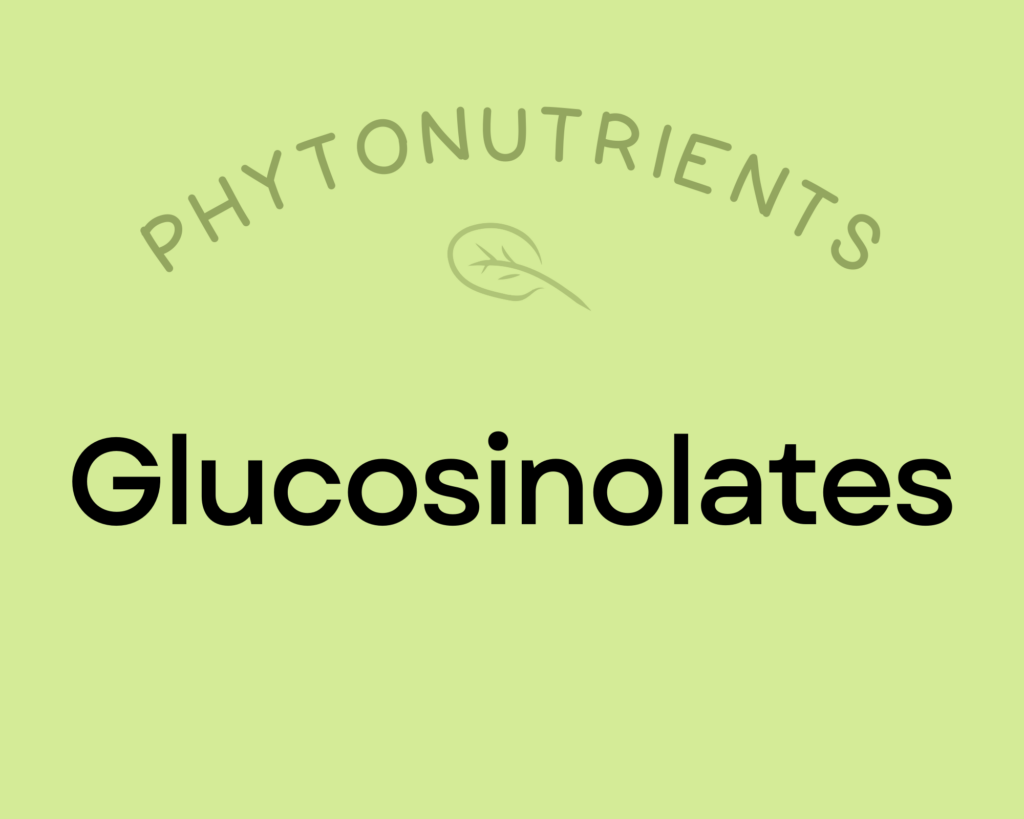
Glucosinolates are well-studied sulfur-containing compounds which break down into bioactive isothiocyanates and indoles when vegetables are damaged (via chewing, cutting, or other processing).
Isothiocyanates (like sulforaphane) are absolute rock stars as far as human health is concerned! Research spanning human epidemiology, animal models, and in vitro experiments show that dietary isothiocyanates are inversely associated with bladder cancer, lung cancer, colon cancer, breast cancer, and pancreatic cancer; some evidence also suggests they may be able to improve ventricular function following heart attacks.
Indoles also have powerful cancer prevention benefits through multiple mechanisms that include modulation of phases I and II detoxification enzymes, regulation of cell cycle arrest, control of cell growth, induction of apoptosis, antioxidant activity, anti-angiogenic effects, and epigenetic regulation. Indole-3-carbinol breaks down into 3,3′-Diindolylmethane (DIM), which is known for its anti-inflammatory, immune system modulating, cancer prevention and estrogen metabolism benefits.
Learn more about glucosinolates here.
Mustard Greens Provide 240% DV Vitamin K
Mustard greens are a fantastic source of vitamin K, providing 240% of the daily value per 2-cup serving!
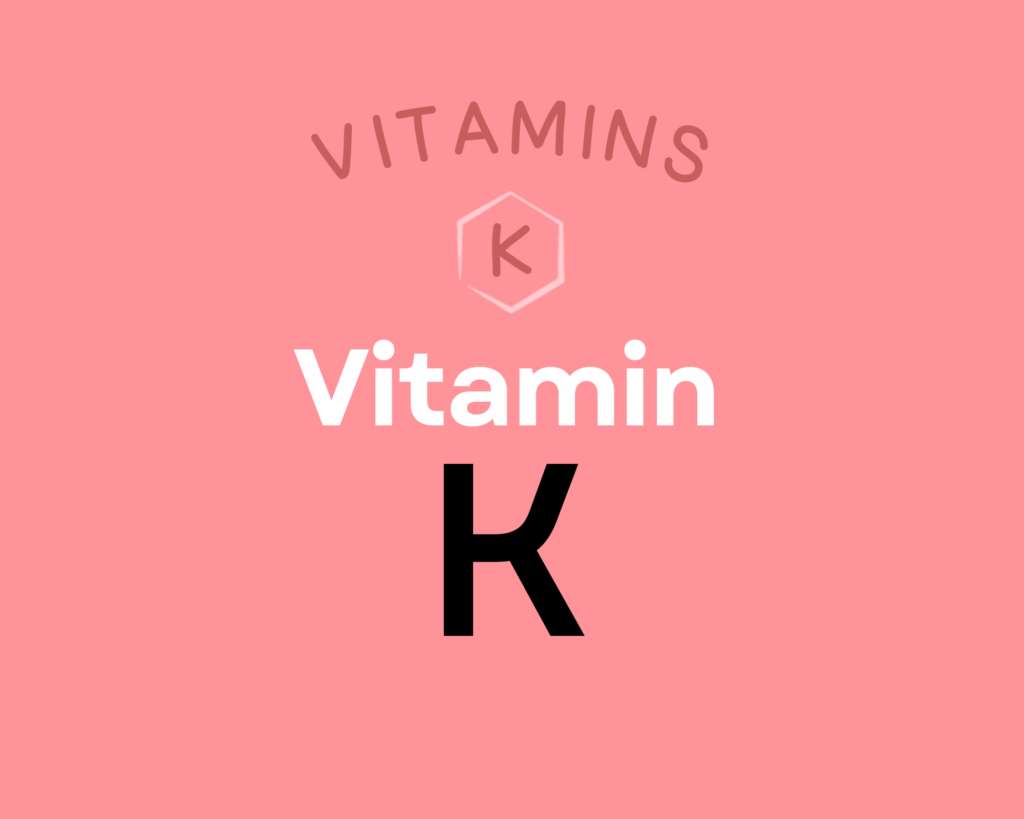
Vitamin K is actually a group of fat-soluble vitamins with a similar molecular structure, existing as K1, multiple isoforms of K2, and the synthetic form K3. This nutrient plays a vital role in coagulation, due to serving as a cofactor for proteins needed for blood clotting; it’s also essential for bone metabolism, cellular function, and the prevention of soft tissue calcification. Getting enough vitamin K2 can help protect against cardiovascular disease, may improve bone mineral density and skeletal health, and may even support endocrine function and brain health; there’s also some limited evidence it has anti-cancer and anti-inflammatory properties. Learn more about vitamin K here.
Mustard Greens Provide 87% DV Vitamin C
Mustard greens are a best source of vitamin C, providing 87% of the daily value per 2-cup serving!
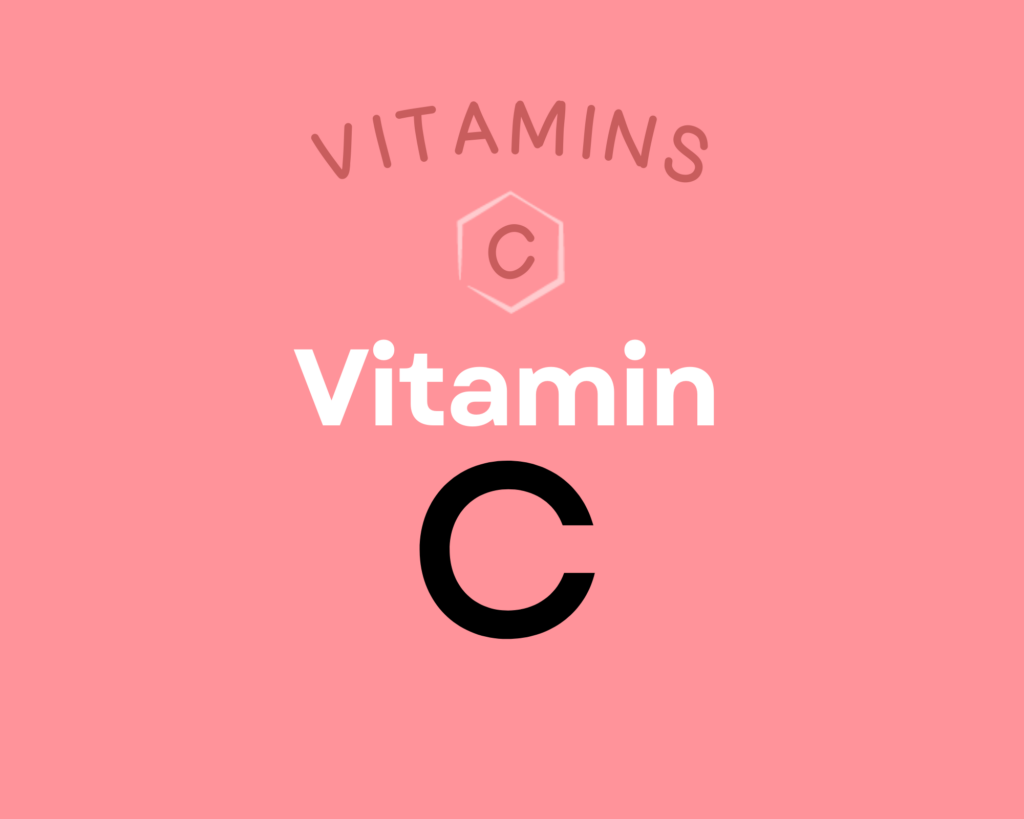
Vitamin C is a water-soluble vitamin that has powerful antioxidant properties (meaning it can help combat oxidative damage from free radicals and reactive oxygen species) and that serves as an enzyme cofactor (meaning it’s needed for enzymes to do their job, for example vitamin C is necessary for collagen synthesis, which is essential for bones, joints, teeth, blood vessels, skin and eyes) and playing important roles in immune system and skin health. Higher intakes of vitamin C are linked to reduced risk of heart disease, some forms of cancer, type 2 diabetes, cataracts, age-related macular degeneration, and gout. Vitamin C can also help regulate the stress response and reduce anxiety, and there’s preliminary evidence that it may also help prevent Alzheimer’s disease. Learn more about vitamin C here.
Mustard Greens Provide 6238.4 μg of Carotenoids
Mustard greens are also a best source of carotenoids, providing 6238.4 μg of carotenoids per 2-cup serving!
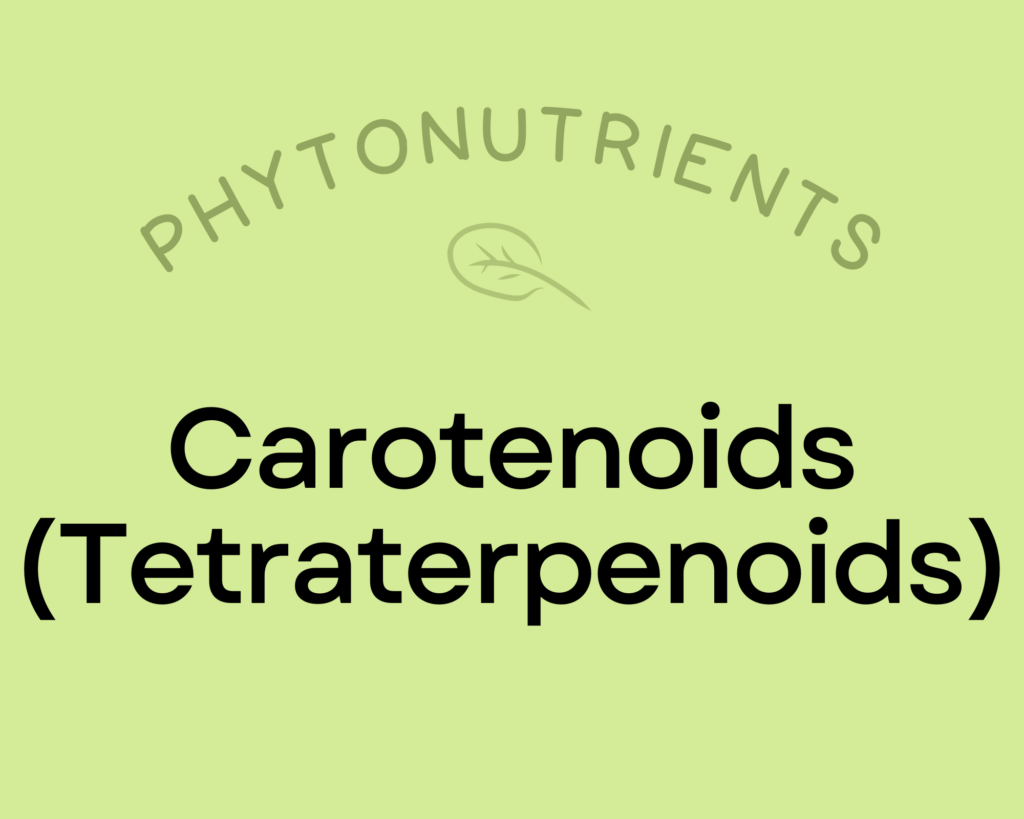
Carotenoids are a diverse group of phytonutrients that are responsible for giving fruits and vegetables vibrant red, orange, and yellow pigmentation. They were one of the earliest phytonutrients ever investigated by scientists (with research dating back to the 1800s!). Across studies, eating foods high in carotenoids appears to reduce the risk of head and neck cancers, supports vision health (particularly age-related eye diseases), may protect against metabolic syndrome and diabetes, and can reduce inflammation. Carotenoids have strong antioxidant properties, and help facilitate communication between cells by promoting the synthesis of connexin proteins, which create gap junctions in cell membranes that allow small molecules to be exchanged (which is part of how cells “talk” to each other!). Consuming carotenoids with fat significantly increases their absorption. Learn more about carotenoids here.
Mustard Greens Provide 412.9 mg of Polyphenols
Mustard greens are a great source of polyphenols, providing 412.9 mg of polyphenols per 2-cup serving!
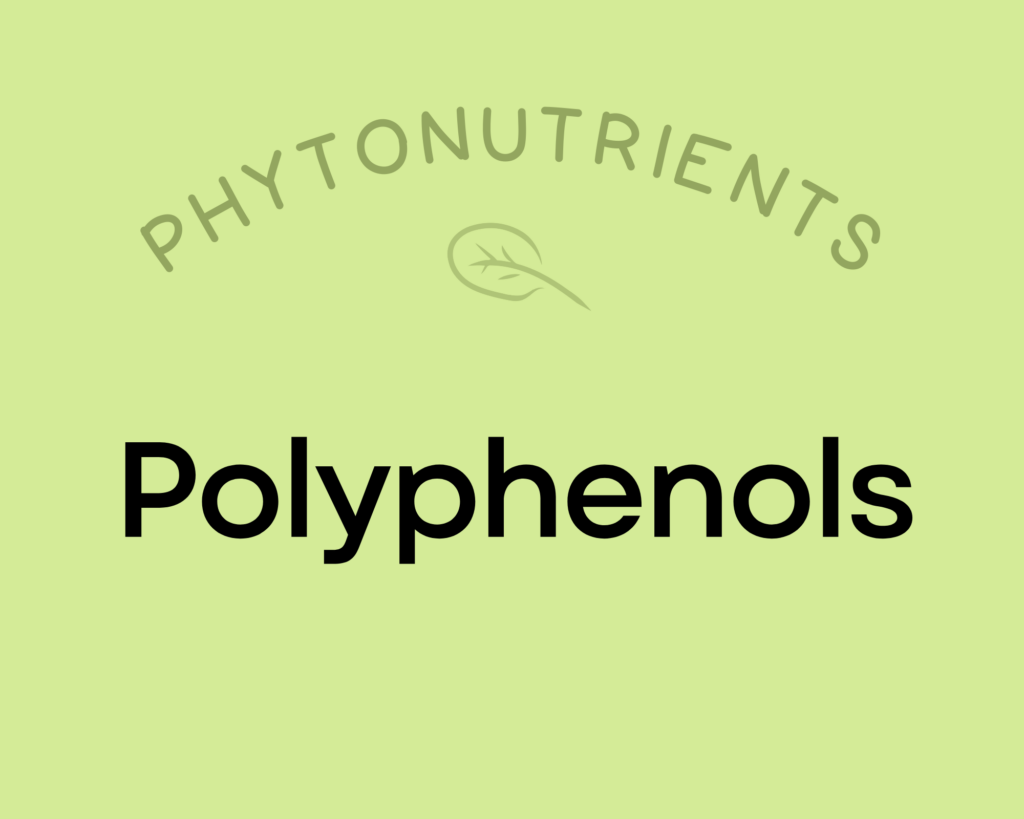
Polyphenols play a huge role in protecting against cancer, heart disease, diabetes, asthma, osteoporosis, neurodegenerative diseases, and other conditions associated with oxidative stress. In fact, a major reason foods like red wine and olive oil (as well as diets rich in both, such as the Mediterranean diet) show up as so beneficial may be due to their high polyphenol content! Along with chronic diseases, supplementing with polyphenols has been shown to protect against infections and reduce the signs of aging. Polyphenols exert their most potent effects by acting as antioxidants—preventing cellular damage by neutralizing hazardous oxygen radicals and improving cellular health as a result (which, in turn, benefits virtually every system in the body). As a result of their antioxidant properties, polyphenols also boost the immune system and protect against both chronic and acute diseases. In addition, polyphenols can help regulate enzyme function, stimulate cell receptors, modulate the functions of inflammatory cells (including T and B lymphocytes, macrophages, platelets, and natural killer cells), alter adhesion molecule expression, affect nerve cells and cardiac muscle cells, and exert antiviral effects. Learn more about polyphenols here.
Mustard Greens Provide 22% DV Manganese
Mustard greens are an excellent source of manganese, providing 22% of the daily value per 2-cup serving!
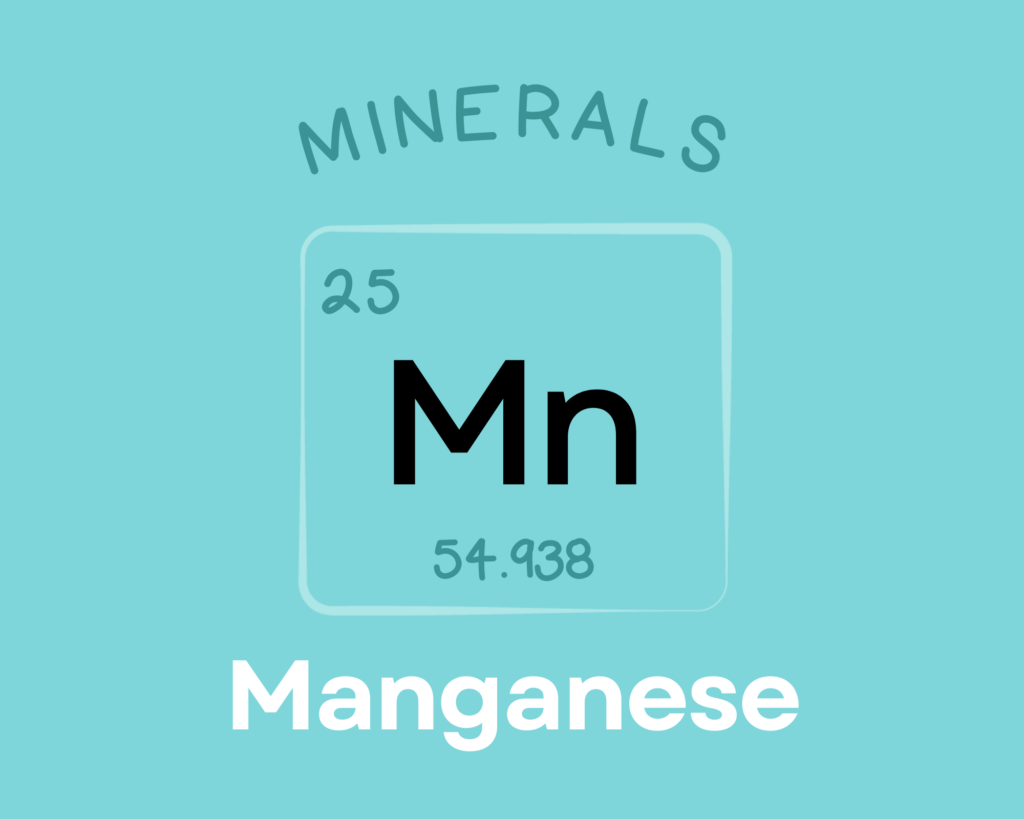
Manganese is an essential mineral that serves as a cofactor and component of numerous enzymes. Through these roles, it’s involved in carbohydrate metabolism, amino acid synthesis, gluconeogenesis, detoxification, lipid processing, free radical defense, bone and collagen formation, and wound healing. Although the research so far is limited, some evidence suggests that manganese can protect against osteoporosis and diabetes, and may even be involved in seizure disorders. Learn more about manganese here.
Mustard Greens Provide 21% DV Copper
Mustard greens are also an excellent source of copper, providing 21% of the daily value per 2-cup serving!
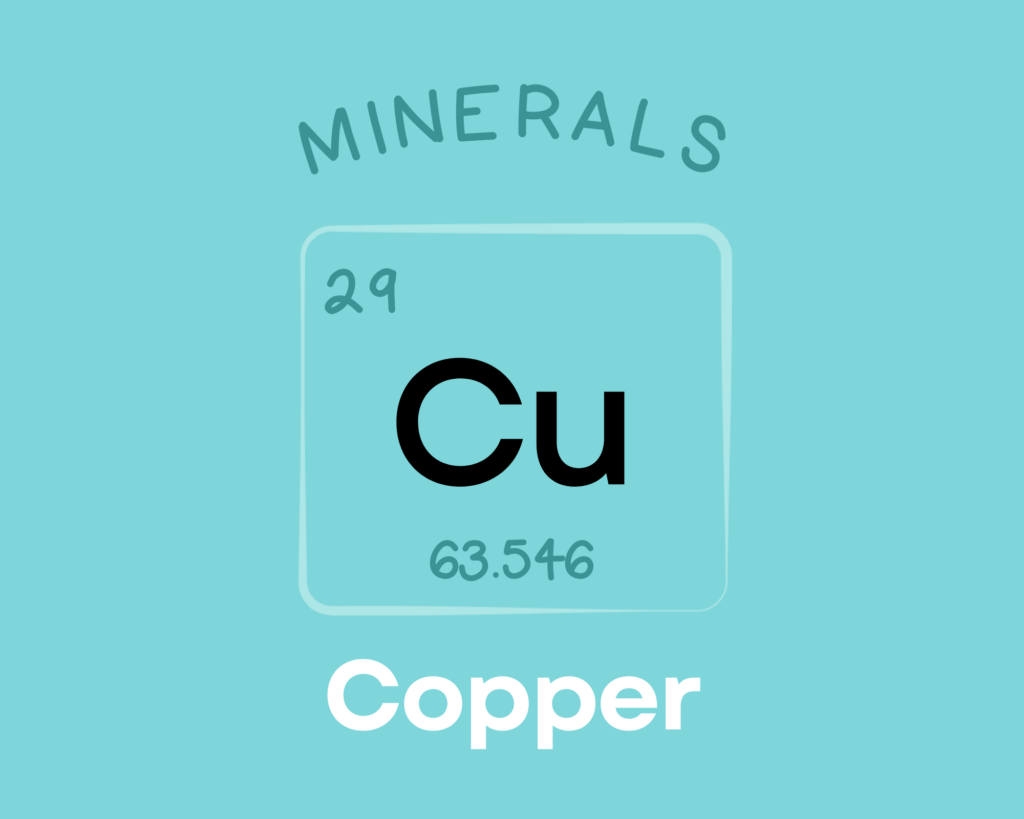
Copper is a trace mineral that’s essential for all living organisms. Copper serves as a component of numerous enzymes and proteins in the body, giving it diverse roles in the growth, development, and maintenance of various organs (including the heart and brain), bone, and connective tissue. Copper is also involved in glucose and cholesterol metabolism, helps regulate gene expression, can scavenge free radicals, and is needed for the production of red blood cells. Learn more about copper here.
Learn What Foods Are the Best Sources of Every Nutrient

The Top 25 Foods for Every Nutrient
The Top 25 Foods for Every Nutrient e-book is a well-organized, easy-to-use, grocery store-friendly guide to help you choose foods that fit your needs of 43 important nutrients while creating a balanced nutrient-dense diet.
Get two “Top 25” food lists for each nutrient, plus you’ll find RDA charts for everyone, informative visuals, fun facts, serving sizes and the 58 foods that are Nutrient Super Stars!
Buy now for instant digital access.
How Much Mustard Greens Should We Eat Per Day?
You know the old aphorism, a Brassica vegetable a day keeps the doctor away! Wait, that’s not how it goes? It should be!
Every serving of fresh, whole vegetables or fruit we eat daily reduces the risk of all-cause mortality by 5% to 8%, with the greatest risk reduction seen when we consume five or more servings per day. In fact, consuming 800 grams of vegetables and fruits daily reduces all-cause mortality by 31% compared to eating less than 40 grams daily. A 2017 meta-analysis showed that 2.24 million deaths from cardiovascular disease, 660,000 deaths from cancer, and 7.8 million deaths from all causes could be avoided globally each year if everyone consumed 800 grams of veggies and fruits every day.
Eating vegetables and fruit in abundance lowers risk of cancer, cardiovascular disease, type 2 diabetes, obesity, chronic kidney disease, osteoporosis and bone fragility fractures (including hip fracture), cognitive impairment and dementia (including Alzheimer’s disease), neurodegenerative diseases, asthma, allergies, chronic obstructive pulmonary disease, age-related macular degeneration, cataracts, glaucoma, depression, ulcerative colitis and Crohn’s disease, rheumatoid arthritis, inflammatory polyarthritis, non-alcoholic fatty liver disease, acne, seborrheic dermatitis, and lowers markers of inflammation. Learn more in Importance of Vegetables and Fruit.
Covering half of your plate with a variety of vegetables (and three quarters of your plate if your starchy food is a root vegetable or winter squash) at each meal is a simple way to easily achieve the goal of 5 or more servings of vegetables daily.
Studies show that, for every 100 grams of cruciferous veggies (like mustard greens), we eat daily, all-cause mortality decreases by 24%!
One to two servings per day of leafy greens is a great target, but there doesn’t seem to be any downside to consuming way more than that!
Studies also show that leafy greens (like mustard greens) offer a huge range of scientifically demonstrated health benefits. For instance, for every 1/3 cup of leafy greens you eat each day you reduce the risk of type 2 diabetes by 13%. Leafy green consumption has also been associated with a 40% lower risk of death from colorectal cancer in men, a 16% reduction in cardiovascular disease and slower cognitive decline in elderly adults. Amazingly, an average of only 1.3 servings per day was associated with the equivalent of being 11 years younger in cognitive age! Taking this all into account means that one to two servings per day of leafy greens (like mustard greens) is a great target, but there doesn’t seem to be any downside to consuming way more than that!
Just remember, it’s always best to mix up the veggies you eat day to day (aiming for a wide variety of different vegetables and fruits throughout the week), and mustard greens definitely have a place at the table.
Easily track your servings of Nutrivore Foundational Foods!

The Nutrivore Weekly Serving Matrix
The Nutrivore Weekly Serving Matrix digital resource is an easy-to-use and flexible weekly checklist designed to help you maximize nutrient-density and meet serving suggestions of Nutrivore foundational foods, all without having to weigh or measure your foods!
Includes a 22-page instructional guide and downloadable interactive guides.
Buy now for instant digital access.
cITATIONS
Expand to see all scientific references for this article.
Clements RS Jr, Darnell B. Myo-inositol content of common foods: development of a high-myo-inositol diet. Am J Clin Nutr. 1980 Sep;33(9):1954-67. doi: 10.1093/ajcn/33.9.1954. PMID: 7416064.
McNaughton SA, Marks GC. Development of a food composition database for the estimation of dietary intakes of glucosinolates, the biologically active constituents of cruciferous vegetables. Br J Nutr. 2003 Sep;90(3):687-97. doi: 10.1079/bjn2003917. PMID: 13129476.
Oh S, Kim K, Choi M. Antioxidant activity of different parts of Dolsan Leaf Mustard. Food Sci Biotechnol. 2016 Oct 31;25(5):1463-1467. doi: 10.1007/s10068-016-0227-z. PMID: 30263431; PMCID: PMC6049281.
USDA Food Central Database: Mustard greens, frozen, unprepared
USDA Food Central Database: Mustard greens, raw


